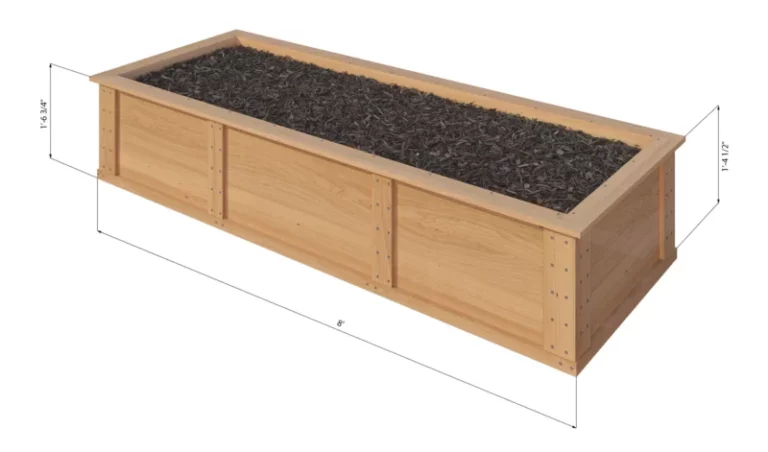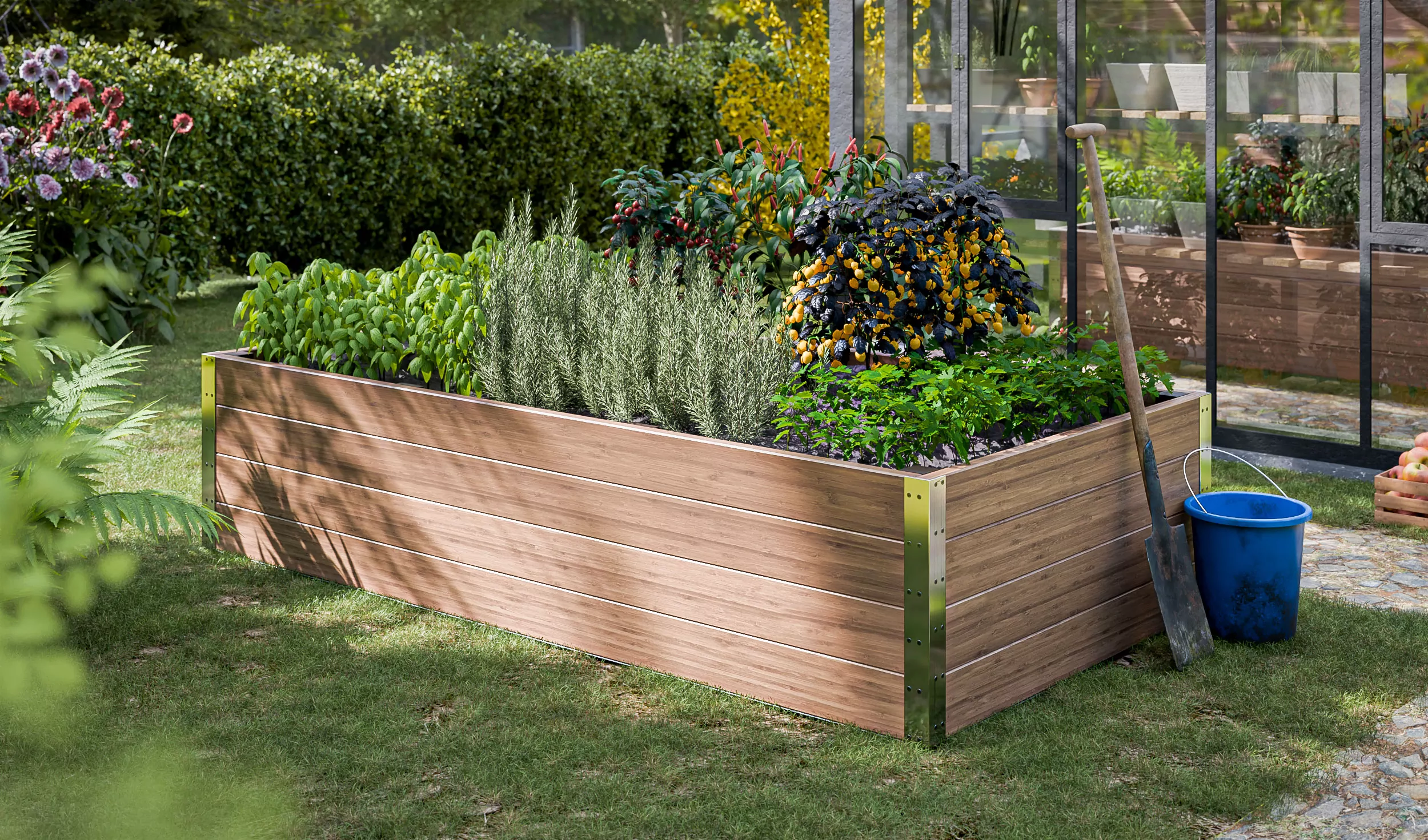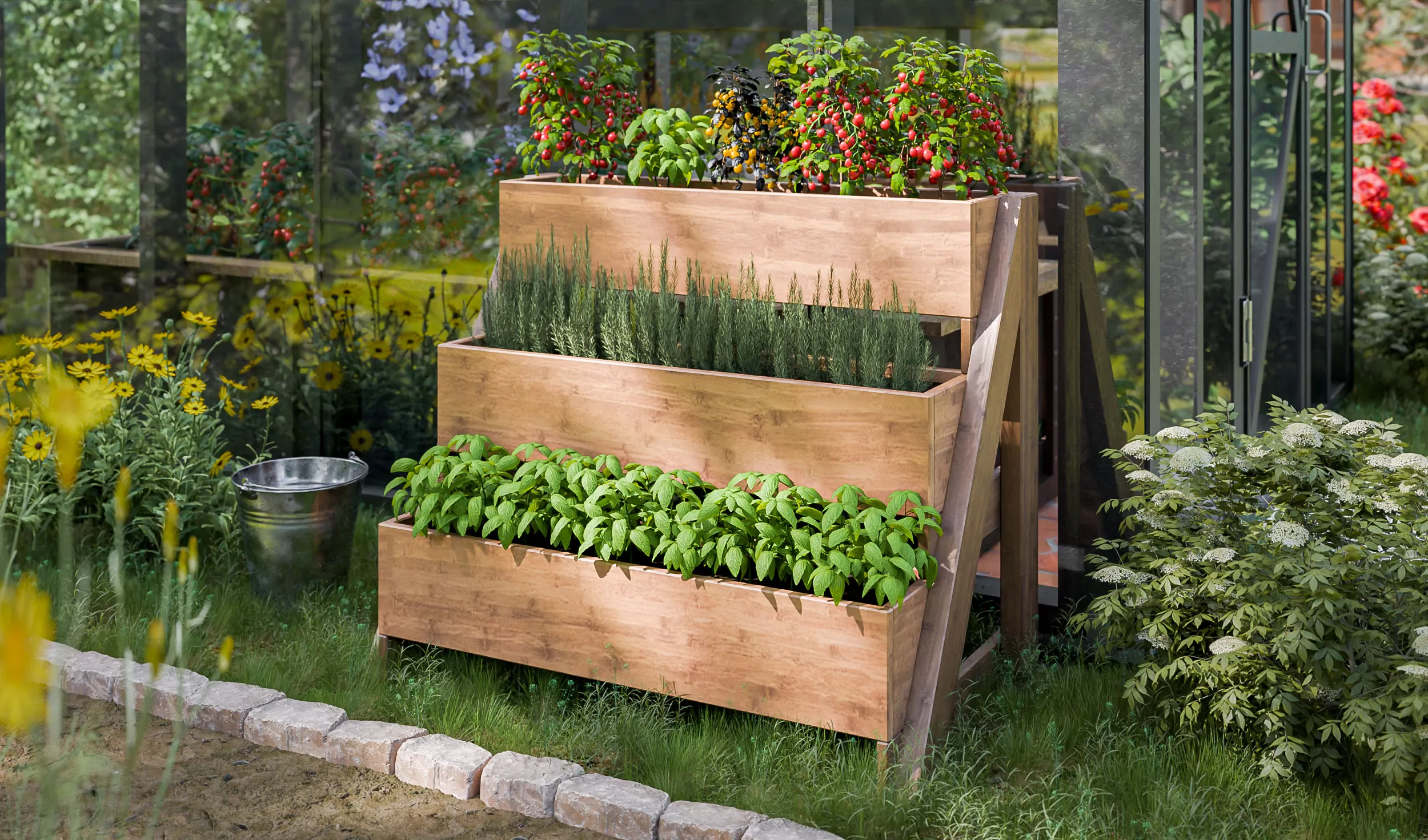Designing a raised garden bed layout isn’t just about looks – it plays a key role in how well your plants grow, how much water you use, and how easy your garden is to maintain. A well-planned raised bed layout can boost vegetable yields by up to 40% and cut water usage by nearly a third. For instance, grouping crops with similar sunlight and watering needs, like placing drought-tolerant herbs together or clustering shade-loving greens, can simplify care and help prevent stress that leads to lower yields. In this guide, we’ll walk you through smart layout ideas to help you grow more with less effort.
How to Choose the Right Size, Shape & Placement for Your Bed
Effective garden bed planning means balancing a variety of factors like what you want to plant, how much sunlight it needs, the space you have available, and any physical limitations that you may need to consider. To create the ideal raised bed layout, consider each of the factors below.
Sunlight
Different plants have different sunlight requirements, so if you want your raised bed layout to flourish, you’ll need to plan around the sunny and shady spots in your yard. And remember: Just because areas of your yard receive some shade, that doesn’t mean you can’t have a raised bed.
If you want an ornamental bed, try some of these recommendations for shade and sun:
- Full sun: Plant annuals like petunias, zinnias, geraniums, or perennials such as coneflower, bee balm, daylilies, or garden phlox.
- Part shade: Try annuals like impatiens, coleus, begonia,s or lobelia, or plant perennials such as hostas, coral bells, astilbes, and bleeding hearts.
- Full shade: The part shade plants listed above will thrive in full shade, too. You can also plant ferns, and if you want spring color, try planting early bulbs like daffodils, hyacinths, or tulips. They’ll get plenty of sunshine early in the spring before the trees leaf out, then start to go dormant when the area becomes shady.
And what about vegetables? Here are sunlight recommendations for common crops:
- Three to four hours of sun is sufficient for leafy greens such as lettuce, spinach, kale, or Swiss chard. In fact, many leafy greens tend to bolt (form seed heads) in the summer heat, so putting them in a part-shade spot can help them stay cooler and last longer.
- Five to six hours will support leafy greens plus root crops like carrots, radishes, potatoes, beets, onions, and garlic.
- Seven to eight hours of sunlight is needed for heavy fruiting crops, including tomatoes, eggplants, peppers, squash, melons, cucumbers, and beans.
Available Space
Now that you have some idea of the plants you want to grow and their sunlight needs, it’s time to consider the space that you have available and what you can do with it.
If you’re building a raised bed garden, that means you likely want gardening space that is larger than the biggest planters you can buy, usually at least 2 feet by 2 feet or larger.
But how large? To find out, do two things:
- Measure various areas of your yard where you think a raised bed will not only look nice, but also get enough sunlight to support what you want to plant.
- Consider everything that you want to plant, not just in terms of quantity, but also the eventual size of the plants. For example, a single zucchini plant requires 9 square feet (3×3), while the same space accommodates 36 carrots (4-inch spacing) or 9 lettuce heads (12-inch spacing).
Physical Limitations
There are a variety of physical limitations that can affect your raised bed layout, too. As you’re planning, consider the following:
Slopes
For long but narrow raised beds, it’s best to place the length along the slope rather than down the slope to prevent soil from washing to the lower end of the bed. Either level the area or build your bed so that the top is level (and the low side is deeper).
Width
Consider how far you can comfortably reach into the bed while standing alongside it. According to The Measure of Man and Woman, the average comfortable reach is 27 inches, meaning beds should be maximum 54 inches wide (27 inches from each side) for dual access, or 24 inches for single-sided access to maintain comfort during extended gardening sessions.
At a minimum, raised beds should be at least 18 inches wide. This will provide enough room to plant root crops, lettuces, brassicas, tomatoes, peppers, and other small to mid-size vegetables.
Height
Height depends on a few factors, and we’ll guide you through them with the following recommendations:
- Six inches is a good height if you want to give beds in your yard a little elevation for aesthetics.
- Twelve inches is the minimum if you’re building a raised bed on a patio or other surface where roots can’t grow into the soil beneath the bed. For larger plants with deeper root systems (like tomatoes, jumbo carrots, potatoes, or squash, build even higher – 18 to 24 inches.
- Two feet is typically the maximum, and a good height if you’d prefer not to do too much bending while working in the bed.
Length
This depends on your available space, but we recommend eight feet, which is the standard in most of our garden plans for raised beds.
Walkways
Building more than one bed, or building near fences, walls, or other obstacles? Ensure that walkways are wide enough not only for comfortable walking or mowing, but also to allow for easy kneeling within the space – about two feet for a person of average height and fitness, or up to four feet for people with mobility constraints.
It’s also wise to place frequently harvested crops like herbs, salad greens, or tomatoes closer to your home or the garden’s main walkway to make them more accessible.

Raised Bed Layout Templates: Popular Configurations for Veggies & Flowers
These popular configurations are based on practical raised bed vegetable garden plans designed to maximize your space, promote plant health through companion planting, and make your garden easier to manage.
Small Raised Bed Garden Layout
Perfect for tight spaces like balconies, patios, or narrow side yards. A small bed (around 2×4 or 2×6 feet) can grow herbs, leafy greens, compact vegetables like radishes, and even a few larger vegetables like tomatoes.

2×8 Raised Bed Vegetable Garden Layout
This layout is ideal for long, narrow spaces. It offers enough room for companion planting without overcrowding. You can plant a mix of root vegetables, leafy greens, herbs, tomatoes, or peppers in rows or blocks.

3×6 Raised Bed Vegetable Garden Layout
A great mid-size option for first-time gardeners. At this size, you’ll have enough space to grow multiple crop families (like tomatoes, brassicas, herbs, beans, or root vegetables) or you can plant a couple of sprawling plants, like zucchinis, squashes, or pumpkins.

4×8 Raised Garden Bed Planting Layout
With 32 square feet of space, you can grow a wide variety of crops and easily reach all parts of the bed. It’s perfect for square-foot gardening or block planting.

Four-Garden Classic
This layout features four raised beds arranged in a square or rectangular shape, usually with paths that intersect at the center. Typical sizes are 2-foot by 2-foot beds or 4-foot by 4-foot.

U-shaped beds
This bed is designed to maximize growing space while keeping everything within easy reach. It allows you to access the center of the bed without stepping on the soil. The dimensions for this layout are usually 12-foot by 12-foot with a 4-foot wide by 8-foot long opening in the center.
 Craftcamp’s U-shaped raised garden bed layout designed for maximum growing space and accessibility
Craftcamp’s U-shaped raised garden bed layout designed for maximum growing space and accessibility
Border garden
Instead of placing garden beds in the middle of your yard, border gardens make use of the space along fences, walls, or edges, making them ideal for small or narrow areas.
 Craftcamp border garden plan designed for narrow spaces
Craftcamp border garden plan designed for narrow spaces
Pro tip: In a border garden, it’s helpful to arrange plants by height. Place taller plants in the back and shorter plants in the front so that your tall plants don’t shade the shorter ones.
Square-Foot Gardening Chart
Raised vegetable garden beds and square-foot gardening are a perfect pairing for efficiency. In traditional row gardens, nearly half the space is taken up by walkways. In contrast, square-foot gardening can deliver the same yield using just 20% of the space by eliminating unnecessary paths and using intensive planting.
Developed in the 1970s by civil engineer Mel Bartholomew, this method divides garden beds into 1-foot sections to create compact blocks of crops. The result? Minimal wasted space and far less time spent weeding between rows.

Here are some guidelines to give you an idea of how to space plants:
- Extra small plants like radishes or carrots can be planted up to 16 per square foot.
- Small plants like beets or spinach can be planted up to nine per square foot.
- Medium plants such as corn or head lettuce can be planted up to four per square foot.
- Large plants like tomatoes, peppers, and eggplants should be planted one per square foot.
- Extra-large plants, including melons, squashes, zucchinis, and pumpkins, need at least two square feet per bush-style plant, and up to 24 square feet for vining varieties to spread.

Here are some examples of how you could arrange plants in common raised bed sizes:
- In a 2×4 bed: Two tomato plants, one cabbage, 16 radishes, 18 beets, and 18 spinach plants
- In a 2×8 bed: Three tomato plants, two peppers, 16 heads of lettuce, 18 beets, eighteen spinach plants, 48 carrots
- In a 3×6 bed: Three tomato plants, three peppers, 12 heads of lettuce, three beanstalks on trellises
- In a 4×8 bed: Four beanstalks on trellises, four tomato plants, four cabbages, 16 heads of lettuce, 64 radishes, 192 carrots
Seasonal Layout Considerations
When planning your raised bed, it’s important to understand that different crops have different growing seasons and harvest times.
Cool-season vegetables thrive in 60-70°F temperatures and can be planted twice yearly: 2-4 weeks before last frost (early spring) for summer harvest, and 10-12 weeks before first fall frost for autumn harvest. These crops include brassicas, carrots, beets, radishes, and peas, and leafy greens like lettuce, spinach, and chard.
Warm-season crops grow best when soil temperatures are above 60°F and daytime temperatures stay between 70–85°F. Wait to plant them until 1–2 weeks after your region’s last frost, when nights consistently stay above 50°F. These crops thrive through summer and into early fall. Some, like tomatoes, peppers, cucumbers, eggplants, and beans, produce steadily through the summer. Others, such as corn, melons, pumpkins, and potatoes, deliver most of their harvest toward the end of the growing season.
Understanding the difference between cool season and warm season crops will help you plan a layout that transitions seamlessly from one season to the next. For example, in a border garden, you may want to plant cabbages and tomatoes in the front for easy access during the summer months when you’ll need to harvest or replant. Meanwhile, you could put pumpkins or potatoes in the back, where they can be left undisturbed until the fall harvest.
Common Raised Bed Layout Mistakes & How to Avoid Them
- Overcrowding: This is the most common mistake, and instead of maximizing efficiency, squeezing in too many plants can lead to competition for sunlight, water, and nutrients, plus poor airflow that can increase the risk of disease and pests.
- Ignoring plant needs: Placing sun-loving crops in shade or water-hungry veggies far from a convenient water source can result in poor growth and small yields.
- Accessibility: Beds that are too wide or too close together can make it tough to weed, water, and harvest.
- Materials: The type of lumber you use can have an impact. Treated lumber seems like a sturdy option, but it will leach arsenic, copper, chromium, and other toxic chemicals into the soil at rates of up to or even exceeding 13mg/L. Our guide about the best wood for raised garden beds can help you pick a safe and durable option.
- Compost: Compost is essential to enrich and replenish soil, but too much can lead to nutrient imbalances that leave crops stunted. For sandy or clay soil, a 1:1 compost ratio works best. Use a 1:2 soil to compost ratio if you’re filling beds with loam or store-bought garden soil.
- Underground pests: If you’re aware of moles or other underground pests in your lawn prior to building raised beds, consider lining the bottoms of your beds with chicken wire. In deeper beds, you can layer branches, twigs, leaves, and compost to both minimize the amount of soil you’ll need to purchase and prevent pests from digging through.
 Craftcamp’s 4×8 raised garden bed with grouped plants
Craftcamp’s 4×8 raised garden bed with grouped plants
Free Layout Plans, Tools & Garden Planners (With Downloadable Resources)
To help you get started, we’ve linked a set of free raised garden bed plans that are ideal for visualizing your garden. These templates are great for testing ideas, adjusting plant placements, and designing a space that works for you.
There are also many digital tools and apps that simplify garden planning. Platforms like Gardena or Planter let you drag and drop plants into custom-sized beds, organize your crops by season, and even get reminders for watering.
Quick Recap: Why Planning Your Raised Bed Layout Matters
Planning your raised bed garden layout takes a little extra effort, but it pays off big time. Here’s why:
- You’ll maximize growing space, even in compact areas.
- Proper spacing reduces competition, leading to larger root systems and higher yields.
- Watering, weeding, feeding, and plant health management will be easier.
If you found this guide helpful, bookmark it for future reference and consider sharing it with a friend who’s getting started with raised bed gardening!


